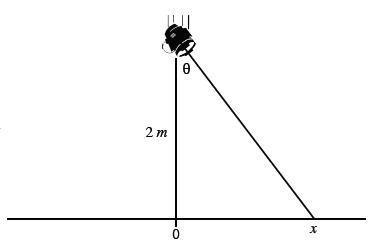Science:Math Exam Resources/Courses/MATH103/April 2013/Question 06 (a)
{{#incat:MER QGQ flag|{{#incat:MER QGH flag|{{#incat:MER QGS flag|}}}}}}
• Q1 (a) • Q1 (b) • Q1 (c) • Q1 (d) • Q1 (e) • Q1 (f) • Q2 (a) • Q2 (b) • Q2 (c) • Q2 (d) • Q3 (a) • Q3 (b) i • Q3 (b) ii • Q4 (a) • Q4 (b) • Q5 (a) • Q5 (b) • Q6 (a) • Q6 (b) • Q6 (c) • Q7 (a) • Q7 (b) • Q7 (c) • Q7 (d) • Q7 (e) • Q8 (a) • Q8 (b) • Q8 (c) • Q9 • Q10 •
Question 06 (a) |
|---|
|
Light Show on the Dance Floor A laser is mounted 2m above the floor (see sketch) and its beam is directed along a straight line on the dance floor. For visual effects, the angle changes periodically and randomly. The angle is chosen uniformly in the interval , that is, the probability density function (pdf) is for and zero elsewhere. Find the cumulative distribution function (cdf), F(x) of the x-coordinate of the laser point on the floor. |
|
Make sure you understand the problem fully: What is the question asking you to do? Are there specific conditions or constraints that you should take note of? How will you know if your answer is correct from your work only? Can you rephrase the question in your own words in a way that makes sense to you? |
|
If you are stuck, check the hints below. Read the first one and consider it for a while. Does it give you a new idea on how to approach the problem? If so, try it! If after a while you are still stuck, go for the next hint. |
Hint 1 |
|---|
|
First find the cdf in terms of |
Hint 2 |
|---|
|
Recall the definition of the cumulative distribution function F of a continuous random variable with probability density function p: |
Hint 3 |
|---|
|
Then use trigonometry to solve for x in terms of |
|
Checking a solution serves two purposes: helping you if, after having used all the hints, you still are stuck on the problem; or if you have solved the problem and would like to check your work.
|
Solution |
|---|
|
Solving first for the cdf in terms of , using that p(t) = 0 for t < -π/4, we have To find the cdf in terms of x we note that, from the diagram, . Solving for θ gives and thus we have completing the problem. |
{{#incat:MER CT flag||
}}











